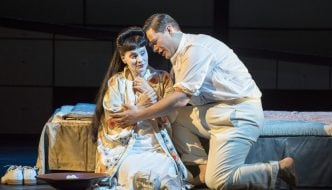Review: ‘What We Do in the Shadows’
December 30, 2014
[Photograph: Kane Skennar]
Timing is everything and What We Do in the Shadows couldn’t have come at a better time. With the laws of vampire mythology being remoulded to accommodate a predominantly female, teenage audience, this New Zealand comedy is a welcome dig at the inherent silliness of the vampire tale – and an affectionate reminder of what vampire films used to be.
Vampires aren’t scary anymore. They’re sexy. They wear open-collared shirts, drive fast cars and pout more than they bite. The phenomenal success of the Twilight films has transformed vampires into something to be desired rather than feared, the idyllic incarnation of the high school heartthrob. With the aid of television programmes like The Vampire Diaries and Hemlock Grove, vampires have become, for true horror aficionados, rather un-cool.
This is not the film that will reinstate the vampire as the grand master of terror; it’s the film that may quash it’s descent into teeny pop trash.

[Image courtesy of The Guardian]
In the vein of This is Spinal Tap and Best in Show, What We Do in the Shadows is presented in documentary – or ‘mockumentary’ – format. This works well for the story and adds to the comedy, though the film struggles with the same problems that found-footage horror films often battle with, most notably the role of the cameraman. How involved are our filmmakers in this gruesome tale? Would they really just stand back and watch a horrible murder taking place? In one instance, a human character is chided for entering an immortal-only event, yet the cameramen are barely noticed. It’s a minor gripe, because the result is hilarious. The jokes are quick-fire and sometimes hysterical.
What We Do in the Shadows’ success lies in painting these vampires as losers, remnants of a past time who simply cannot keep up with the modern world. After all, it’s not that impressive being a vampire if you can’t work a smartphone. And getting into clubs is considerably more difficult when the bouncers have to invite you in. This juxtaposition of vampire lore and the modern world is where the film is at its funniest. There are constant visual gags and one character’s comparison between virgin blood and a ham sandwich will keep you chuckling long after the film is over.
There’s also a wonderful hark back to the classic vampire film Nosferatu in the character Petyr, played by Ben Fransham. Over 8,000 years old, Petyr is the archetypical grand master vampyr, a disgusting, wizened creature who lives in the basement. In a near-silent role, Fransham threatens to steal the film away and his character is woefully underused. Amidst the gleefully whimsical comedy, Petyr is a nice reminder that vampires should, above all, be scary.

[Image Nosferatu’s Shadow, Wikipedia]
Surprisingly, for a low-budget comedy, the visual effects on display are excellent. What We Do in the Shadows may poke fun at vampires, but it doesn’t shy away from the gory brutality of the vampire myth. In its own way, this is the most believable vampire film ever made. It’s relatable. In the character Nick, played by Cori Gonzalez-Macuer, we experience what it would be like for an everyday shlub to be granted immortality, showing off his fangs and lamenting not being able to enjoy cheesy chips. The film is let down by its climactic showdown, where the effects don’t stand up to the rest of the film. As is the case in most horror films, showing a bit less might have provided so much more.
But this isn’t a horror film. If you’re after scares, What We Do in the Shadows is in short supply. What it does offer is plenty of laughs. Some of the jokes fall flat (one grey-faced transformation proves a weak throwback) and, even at 85 minutes, the concept feels a bit stretched-out, but there are enough whimsical, witty moments to sustain attention. The supporting characters are particularly well-sketched, the inclusion of a vampire-doting housewife verging on satire, her unrelenting devotion to Jonathan Brugh’s Deacon reminiscent of the women who blindly marry death-row prisoners. And in Stu, the witless human played by Stu Rutherford, the creators of What We Do in the Shadows have found a sublimely tacit comic foil.
What We Do in the Shadows has been met with a lot of hype, possibly unjustified, but the film is undeniably timely. If ever there was a time to poke fun at the vampire phenomenon, it’s now. This film is keen, quick, affectionate and almost impossible to dislike. If you don’t leave in stitches, you’ll at least leave with a smile on your face. And possibly a dislike of werewolves…
Joe Saxon




Comments